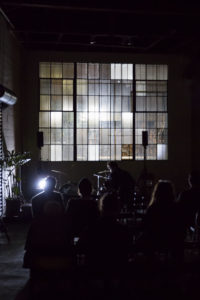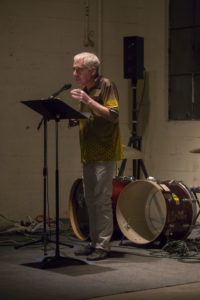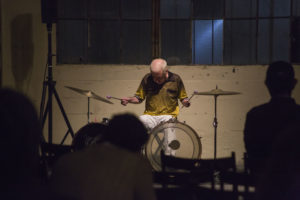Sam Ashley & John Krausbauer in concert
- Sam Ashley & John Krausbauer in conversation
Sam Ashley & John Krausbauer performed at 356 S. Mission Road on February 4th, 7 PM. In conjunction with this concert, the artists discussed their individual practices with 356 Mission:
356 Mission: John, strobelights play an role in your live performances. For you, what’s the effect of this staccato, sharp rhythm against the steady intonation of the full spectrum, broad tonality of the sound you create?
John Krausbauer: Stroboscopic lighting has been part of my live performance, specifically for my amplified strings music group/collective, Ecstatic Music Band, and my solo music. More recently I’ve used it in a few other contexts. However, there’s a great deal of music I’ve made that doesn’t utilize this strategy. The use of the strobes has always been with an intention to create a TOTAL and immersive experience. It was my first (and so far, only) attempt to really consider the possibility of affecting a music-listening audience visually and in this case with light, or “visuals”. The staccato beating of the light pulse actually lines up quite well with all the “beating tones” created in the sonic fabric of the drone. The tuning systems help out with this to create a myriad of micro details. It would seem from a topical inspection that you are hearing only the sonic continuous drone against the pulsing light, but in actuality there’s a whole sea of beating rhythms occurring inside the drone. So for me, being attuned to this, I see the relationship of the two very symbiotically. If the subtleties of the audio experience are lost, the overall effect of high volumes, long endurance, and strobing lights usually creates an immersive experience.
There’s a place I’m trying to get at where the listener is both pacified by the endurance, drone, and repetition, but is also attentive to the multitudes of detail in the sound, the pyschoacoustic effects, the high volumes pressurizing the air, and in some cases, the stroboscopic lighting. It’s an awakened trance type state I’m searching for – for myself, and hopefully, for the participants of the music and the listeners.
356: Your recent compositions have been made with accordions, violin, electronics, and voice. Are there certain instruments that are better attuned for drone? Any tools that have taken you by surprise in this exploration?
JK: My interests as a music player are as a multi-instrumentalist. When possible, I like to employ the instruments that seem best fitted for the music, rather than adapting the music to the instrument. I’ve never been interested in virtuosity, or being a “guitarist” or “violinist”, but simply utilizing and engaging the instrument as a tool to achieve my musical aims, whatever those may be. That does often involve becoming familiar enough with any given instrument and having some type of command over it, but always as a means to an end. As for the particular instrumentation I’ve utilized, it sometimes is as simple as having access or use of certain instruments or searching out collaborators who are players of specific instruments.
Although some instruments (harmonium, cello, bagpipes, etc) mechanically/sonically lend themselves to “drone,” or better said, creating a drone, any instrument seems capable of coaxing a drone out of it. My acquiring of a violin was with the intention to have use of a non-fretted, bowed string instrument, therefore microtonally capable and with a continuous sound (drone), to explore the potentials of “just intonation” and alternate tuning systems. It’s been very useful in these ways.
356: Sam, your work involves what’s been described as “an experimental, non-religious mysticism.” While that description sounds a little arcane, seeing it in practice during your performance feels very human and universal. Do you find most people have a familiarity with this mysticism? In what moments in their own lives might people manifest it?
Sam Ashley: Everybody has an intuitive sense of the possibility. It’s my job to propose that they can expand that intuition.
356: In discussing this mysticism, you use the phrase “find out for yourself.” “Finding out for yourself” can be a solitary, individual experience. What is the effect of undergoing this action in a public way?
SA: “Public” vs “private” is not a problem. Ultimately they are the same.
- Sam Ashley performance
February 4th, 2016
at 356 Mission, Los Angeles -
Sam Ashley
&
John Krausbauer
In concert at 356 S. Mission Road
Thursday, February 4th, 7 PM
FREE
Tags: John Krausbauer, Sam Ashley






